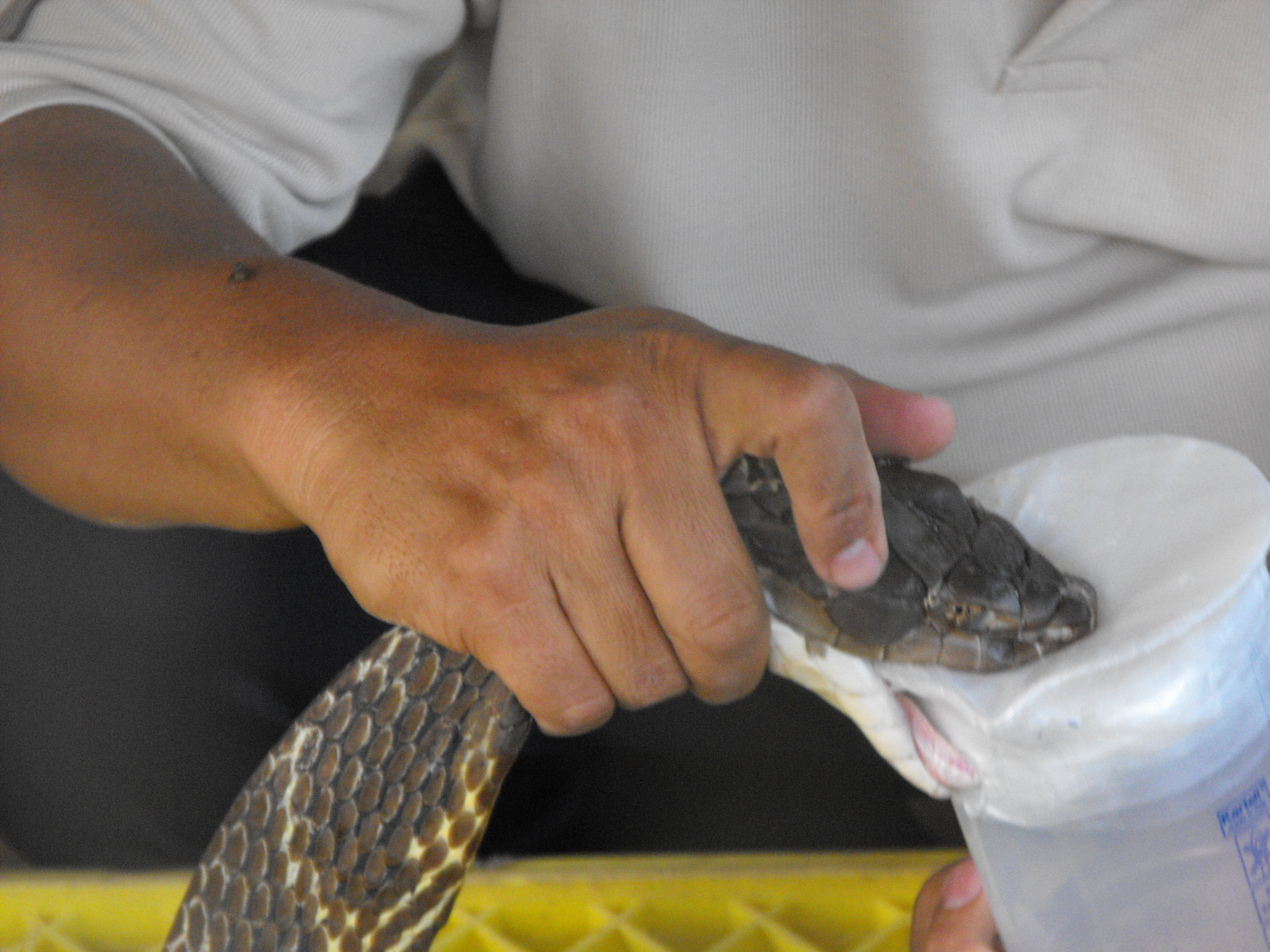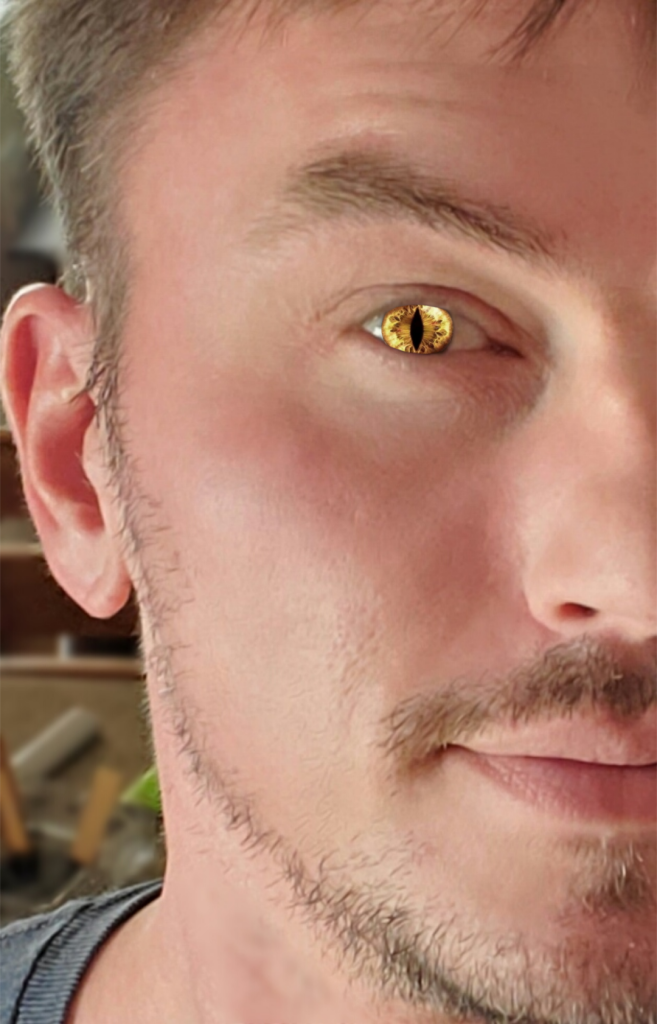
Syafiq Asnawi Zainal Abidin via Flickr

Audio By Carbonatix
“I’m still alive..!!” Navy veteran Zach Phillips, who lives in the mountains outside of Aspen, posted to his Facebook page on July 3.
Phillips hadn’t been in a natural disaster, or suspiciously offline; he was announcing to the world that he’d survived his first administration of a snake venom cocktail. A solution of king cobra venom and western diamondback rattlesnake venom had been carefully droppered onto a pentagonal cluster of small burns on the skin of his shoulder, known as a burn port.
“I feel amazing and can already feel the pain relief,” Phillips continued in his post. “My favorite medicines come from the places that people fear the most.”
Phillips has done venom applications more than a dozen times since that first dose, using them to treat residual back pain and post-traumatic stress disorder. The venoms go beyond pain relief, he says. “It gives you an almost instant clarity and peace and relaxation,” Phillips tells Westword. “About three minutes into it, you’ll start to feel an onset of a type of euphoric high that’s similar to a cross between sativa edibles and a small, small dose of morphine.”
On his fourth venom application just over a month later, Phillips had the venom applied to burn ports in two spots, the cervical and lumbar portions of his spine. “The pain relief gained from this treatment was astronomical!!!” he posted to Facebook on August 7. “I did experience an increase of collagen swelling in the facial features and especially the lips. (Looks like I was dipped in the ‘Fountain of Youth’)…This time I did however experience a slight increase in heart rate. But nothing to be too concerned about.”
Kids: Don’t try this at home.
Warns professor Steve Mackessy, an expert in snake venoms who runs the Mackessy Venom Analysis Lab at the University of Northern Colorado: “You should avoid that at all costs. There are some very good and effective drugs that have been developed from venom, but there’s a big difference between an isolated single compound and a crude venom.”
Mackessy’s UNC lab focuses on identifying compounds in snake venom that improve the health of people with debilitating diseases and disorders — ” harnessing venom compounds with promise for drug discovery research and development. Unlike many other labs, the MVAL extracts its own venom directly and has direct access to many species that have been completely unknown until recently,” according to its website.

Back in the summer of 2006, Phillips was deployed on the USS Nashville, where he participated in an evacuation operation outside Lebanon after Israel and Hezbollah began battling in the south of the country (among the evacuees was Anthony Bourdain and his No Reservations crew, who had been filming there when the missiles started falling). A month later, with a contingent of Marines onboard, Phillips had just hung up a satellite phone at 0100 hours after a call with his then-wife back in the States, when he smelled something burning.
“It smelled like a combination of chemicals and materials,” he recalls. Phillips launched a mad scramble to wake the Marines sleeping in nearby compartments. “If I hadn’t gotten out of there and got the Marines when I did, we could have easily been trapped in there,” he says. “The fire marshal reports said it reached almost 700 degrees in the room I was in.”
In the panic, Phillips says he fell fifteen feet down a ladder well and severely sprained his lower back. On top of that, he was diagnosed with PTSD; the smell of things burning can still be triggering, he notes.
He returned stateside to Texas at the end of 2008, where his wife was suffering from an as-yet-undiagnosed brain cancer. “My hands got kind of busy with trying to figure out and untangle what’s going on between my military career, my personal life at home, and what I went through during deployment that I hadn’t dealt with yet,” he recalls. Doctors overprescribed him a slew of medications for pain, for anxiety, for depression, to sleep, to stay asleep. “It’s insane that I survived it,” he says.
By 2014, Phillips had seen and read about veterans who were using cannabis to treat PTSD; he left Texas and moved to Colorado, where recreational marijuana use had been legalized as of January that year. Phillips then met Matt Kahl, since deceased, who’d founded an organization called Veterans for Natural Rights that advocated for plant medicine solutions for traumatized veterans.
Phillips became an advocate for cannabis treatment for veterans and became interested in the therapeutic effects of psychedelics like psilocybin mushrooms and ayahuasca, which he experienced in a series of ceremonies in 2016. In 2018, his experimentation took a tangent when he was introduced to kambo.
Kambo is the secreted poison of the giant leaf frog, and application of the poison to burns on the skin is a folk-medicine practice among some indigenous peoples in the Amazon. The kambo ceremony has made its way to the psychedelic-adjacent alternative medicine realm in the West, and Phillips did his first kambo ceremony in 2018.
Kambo application is hardcore for the recipient, with side effects including nausea, vomiting, tachycardia and diarrhea. There is no euphoria and there are no hallucinations; it’s a purification or cleansing ritual that Phillips has undergone three times now.
The medical establishment does not back claims that kambo — or crude snake venoms, for that matter — has therapeutic benefits. Australia’s Therapeutic Goods Administration banned the poison in 2021, noting rare deaths from the ceremony and concluding that kambo has no medical benefit.
On his journey from cannabis to ayahuasca to kambo, Phillips encountered a snake venom fan named Steve Ludwin on YouTube. VICE had featured Ludwin in several videos, including one titled “Getting High Injecting Snake Venom.” Ludwin remains an advocate of snake venom treatments, and says he’s been injecting venoms for thirty years.

When news happens, Westword is there —
Your support strengthens our coverage.
We’re aiming to raise $50,000 by December 31, so we can continue covering what matters most to this community. If Westword matters to you, please take action and contribute today, so when news happens, our reporters can be there.
“I’d been open to this for a long time, and I’ve done kambo three times prior to starting these serpent venoms,” Phillips says. He doesn’t milk the venomous snakes himself, but has a mentor — about whom he will reveal little — who provides the venoms and guides him through the applications.
“My philosophy is the difference between a medicine and a poison is dosage,” Phillips says. “If you think about it, there are all these pharmaceuticals out there that could kill you, but if you’re taking it at or under the recommended dosage, then you’ll be safe. It’s really no different with these venoms and kambo and neurotoxins.”
According to Phillips, western diamondback rattlesnake venom contains thousands of peptides that are potentially therapeutic. “With the king cobra, it works on the nervous system, then the rattlesnake mixed with it works on the blood and circulatory system,” he says.
“The guy who’s training me on this put this mixture together with the intention to treat specifically what I’m treating,” Phillips adds. “This isn’t necessarily for everyone, and it might not be safe if you have something else additional going on.”
UNC’s Mackessy goes much further than that. “If you’re taking [venom] in a crude form, you’re kind of playing Russian roulette,” he tells Westword. “I use the analogy that if you want to remove a tumor, you could use a shotgun, and it would take out the tumor, but a lot of collateral damage would occur. Venoms can be a good source of individual compounds, but the crude, full-spectrum venom is nothing to mess with.”
Key ingredients in weight-loss drugs that have recently swept the nation — GLP-1s like the semaglutide found in Ozempic and Wegovy — were first discovered in Gila monster venom, for example. “These are purified compounds that are well characterized, and that’s a big difference from something someone makes into a paste and throws on the back of your neck,” Mackessy says.
“Exactly why this individual is getting relief from treatment with various types of venoms is a matter of debate and discussion unless you have controlled experiments compared to a placebo,” Mackessy adds. It’s hard to say that there’s anything really effectively going on there. There could be, but it’s unlikely.”
Phillips dismisses Mackessy’s criticism, and says he’s kept meticulous notes on each of his venom application experiences to document the health benefits he’s receiving. “If I had a doctorate, I couldn’t go around saying ‘Everyone should use this venom,’ because then I’m going to have people coming to sue me,” is how he characterizes Mackessy’s cautionary statements.
“Even my mentor told me that I’m very in tune with my own body and that it takes people who have this deeper, higher intelligence with intuition and attention to detail like I do,” Phillips says. “So it’s not like just any Joe Schmo who lacks attention to detail and doesn’t understand their body well enough, they’re not going to be a good fit for this kind of work.”